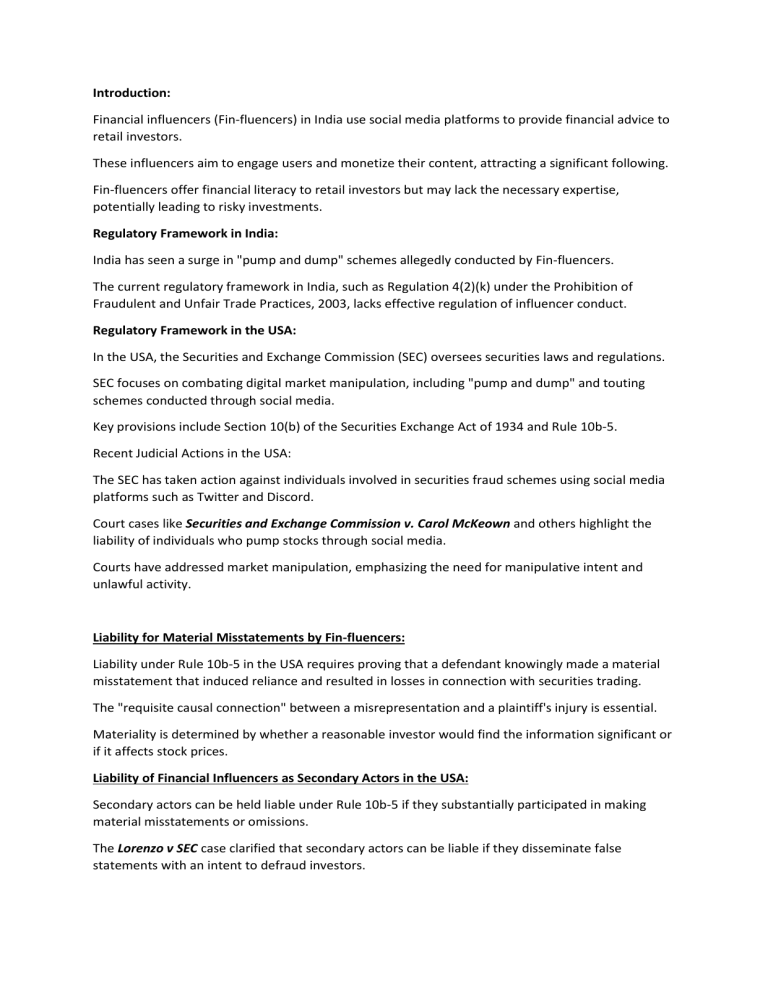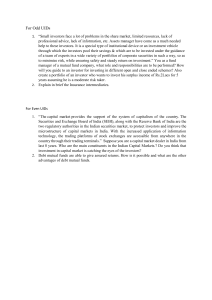Fin-fluencer Liability: India vs. USA Regulatory Frameworks
advertisement

Introduction: Financial influencers (Fin-fluencers) in India use social media platforms to provide financial advice to retail investors. These influencers aim to engage users and monetize their content, attracting a significant following. Fin-fluencers offer financial literacy to retail investors but may lack the necessary expertise, potentially leading to risky investments. Regulatory Framework in India: India has seen a surge in "pump and dump" schemes allegedly conducted by Fin-fluencers. The current regulatory framework in India, such as Regulation 4(2)(k) under the Prohibition of Fraudulent and Unfair Trade Practices, 2003, lacks effective regulation of influencer conduct. Regulatory Framework in the USA: In the USA, the Securities and Exchange Commission (SEC) oversees securities laws and regulations. SEC focuses on combating digital market manipulation, including "pump and dump" and touting schemes conducted through social media. Key provisions include Section 10(b) of the Securities Exchange Act of 1934 and Rule 10b-5. Recent Judicial Actions in the USA: The SEC has taken action against individuals involved in securities fraud schemes using social media platforms such as Twitter and Discord. Court cases like Securities and Exchange Commission v. Carol McKeown and others highlight the liability of individuals who pump stocks through social media. Courts have addressed market manipulation, emphasizing the need for manipulative intent and unlawful activity. Liability for Material Misstatements by Fin-fluencers: Liability under Rule 10b-5 in the USA requires proving that a defendant knowingly made a material misstatement that induced reliance and resulted in losses in connection with securities trading. The "requisite causal connection" between a misrepresentation and a plaintiff's injury is essential. Materiality is determined by whether a reasonable investor would find the information significant or if it affects stock prices. Liability of Financial Influencers as Secondary Actors in the USA: Secondary actors can be held liable under Rule 10b-5 if they substantially participated in making material misstatements or omissions. The Lorenzo v SEC case clarified that secondary actors can be liable if they disseminate false statements with an intent to defraud investors. Overall, the regulatory framework in the USA offers more clarity on the liability of financial influencers in cases of market manipulation and material misstatements compared to India, which is still grappling with regulatory challenges in this domain. I. Dissemination of False Statements by Fin-fluencers A. General Liability Fin-fluencers can be held liable for disseminating false statements under certain conditions, fulfilling the requirements of regulatory rules. B. Regulatory Framework in India The Indian capital market is regulated by SEBI (Securities and Exchange Board of India), which deals with emerging issues faced by market participants. SEBI is challenged with effectively regulating Fin-fluencers on social media platforms who provide financial advice to retail investors. C. Investment Advisor vs. Fin-fluencers Indian law distinguishes between traditional "investment advice" and advice provided through print or digital media, excluding the latter from specific regulations. D. PFUTP Regulations and Fin-Fluencers SEBI has established PFUTP (Prohibition of Fraudulent and Unfair Trade Practices) Regulations to combat unfair trade practices, including dissemination of false information. Recent amendments to PFUTP Regulations include the provision for recklessness on the part of the wrongdoer. E. Pitfalls of Loss Causation under PFUTP Regulations Indian regulations do not require proof of loss causation by investors due to misinformation. This contrasts with the U.S., where loss causation is essential to establishing liability for disseminating false information. F. Impact of 'Artificial Inflation of Price' and 'Materiality' Indian regulations are silent on whether artificially inflating stock prices through false statements is considered material. In the U.S., such actions are deemed material after the Dura Pharmaceuticals case. G. Application of 'Fraud-on-the-Market' Theory In the U.S., plaintiffs are not required to prove loss causation for class certification in securities fraud cases. The "fraud-on-the-market" theory presumes reliance when misstatements affect stock prices. Introducing this theory in India could ease the burden of proof for investors and help regulate Finfluencers. II. Liability for Anti-Touting Activities by Fin-fluencers in the USA A. Touting in the USA Touting involves endorsing securities in exchange for undisclosed compensation. Section 17(b) of the Securities Act of 1933 in the USA prohibits promoting securities without disclosing compensation. B. Example of Kim Kardashian Kim Kardashian was charged by the SEC for unlawfully touting a crypto security without disclosing her compensation. This case demonstrates liability under Section 17(b) of the Securities Act of 1933. III. Deciphering Anti-Touting Provisions in India A. Challenges in India India faces challenges related to securities endorsements on social media platforms, similar to the Kim Kardashian case. SEBI must address the issue of securities endorsement through social media, which can pose risks to retail investors. These key points provide an overview of the liability of Fin-fluencers for disseminating false statements and anti-touting activities in both India and the USA.





